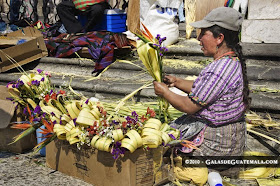Chicken Pulique
You already know that recado is the shared name for any thick sauce used in the traditional cuisine. There is a wide variety of recados, and depending on the main ingredients and preparation methods, some can be brownish –like the pepian’s, others are green or red, and the pulique recado is of an intense yellow.  The unique flavor of this dish is provided by the apazote (Chenopodium ambrosioides), also known as epazote, vomiqueira herb, pazoli, huacatay, among others. In case you don’t find fresh apazote, you may try looking for dried apazote and using only 3-4 tablespoons. If dried apazote is neither an option, you may try substituting it by 1 part of sage and 3 parts of culantro.
The unique flavor of this dish is provided by the apazote (Chenopodium ambrosioides), also known as epazote, vomiqueira herb, pazoli, huacatay, among others. In case you don’t find fresh apazote, you may try looking for dried apazote and using only 3-4 tablespoons. If dried apazote is neither an option, you may try substituting it by 1 part of sage and 3 parts of culantro.
Recado Ingredients
1 lb of fresh Roma tomatoes
½ lb of fresh miltomatoes (also known as tomatillos)
1 large onion (about 1 cup)
2 dried “guaque” chili (also known as guajillo), seedless
2 garlic cloves
1 cinnamon stick (about 1 inch)
1 teaspoon achiote (annato) powder (you may substitute it with paprika)
½ teaspoon black pepercorns
½ teaspoon cummin seeds
¼ teaspoon cloves
1 cup of fresh apazote
Salt to taste
¼ cup of corn flour (corn tortillas-purpose flour) to be added at the end of the cooking process
Other Ingredients
6-8 chicken thighs, skinless (or 1 large chicken cut in pieces)
Optional
Big chunks of güicoyitos (zuccini), potatoes, and carrots
Preparation
Place the chicken thighs (and vegetables if you are using some), with about 3 cups of water, salt, and pepper into a large pot. Bring to a boil, reduce the heat, and simmer until the chicken is no longer pink and the vegetables are tender, about 20 minutes.
In a separate pot with about 2 cups of water, cook all the recado ingredients (except the corn flour) for about 10 minutes, discard the cinnamon stick, and blend the rest of the ingredients incorporating the corn flour until everything is smooth and well integrated.
The next traditional step, calls to fry the recado in about 2 tablespoons of vegetable oil (your preference of canola, corn, or olive oil), bring it to a boil and let it simmer until it thickens, about 3-5 minutes. To avoid extra fat, I only bring the recado to a boil and let it simmer to thicken.
Once the recado is thickened, add it to the pot with the chicken (and vegetables), verify the seasoning (salt and pepper) and consistency (if too thick, you may need to add water or chicken stock; if too thin, you may need to add a teaspoon at a time of corn flour and mix well), and let simmer altogether for another couple of minutes to let all the flavors mingle.
You can serve Pulique with Boxboles (recipe below) or rice pilaf on the side and garnish it with some apazote (or culantro) fresh leaves.
Boxboles
To give you an idea about this delicacy, I would say that Boxboles are the Mayan version of the Greek Dolmades because just like these, Boxboles are stuffed leaves.
 Ingredients and Preparation
Ingredients and Preparation20 güisquil (also known as chayote or pataste) or pumpkin leaves. I know, right now you are thinking, where am I going to find those “güisquil” or even the pumpkin leaves? Don’t worry, I live in The Woodlands, so I am thinking exactly the same... Try with any greens (collards, spinach, etc.) you can find in your city, removing the woody stems, if any. Wash and dry them very well. Set aside.
Mix together the following ingredients, until everything is well combined and the dough-like mixture is soft but firm
2 cups of corn flour (corn tortillas-purpose flour), mixed with water as per the instructions in the package
2 tablespoons of butter
½ cup of sour cream
½ cup of dried cheese (Zacapa, parmesan, cotija)
1 pinch of ground thyme
1 pinch of ground bay leaves
Salt and pepper to season
Make small thick sticks (thumbs-like) with the dough and wrap each one in a leaf.
To cook the Boxboles you may use the bain-marie (double boiler) technique or a steamer for about 30 minutes.
Tip to serve the Boxboles
You can use them on the side of a dish like Pulique, or as apetizers covered with this simple sauce: blend together with a very small amount of water, 2 roma tomatoes, 2 green onions, 2 tablespoons of roasted pumpkin seeds, and depending on your taste, hot pepper flakes or powder, until the mixture is very smooth. Season with salt and ground black pepper. Bring it to a boil and let it simmer for about 2 minutes.
Chilacayote Beverage
Don’t make that funny face! I am not making any of these names. They are real, edible, glorious ingredients to satisfy even the most sophisticated taste.
The chilacayote (also known as fig-leaf gourd, alcayota, chiverre, cidra, among others) is a Cucurbita ficifolia that according to Wikipedia is cultivated around the world and it happens that is one of the specialties in El Quiche.
All you need is one small and clean chilacayote, cut in pieces and cooked at medium heat for about 20-30 minutes with water, 1 large cinnamon stick, about 10 each all spice and cloves, and panela or sugar. Let it cool and serve with ice. Before serving, you can add freshly squeezed lime or lemon juice and rectify the sweetness. Personally, I like to garnish my glass with some of the chilacayote strings. Buen Provecho!























































